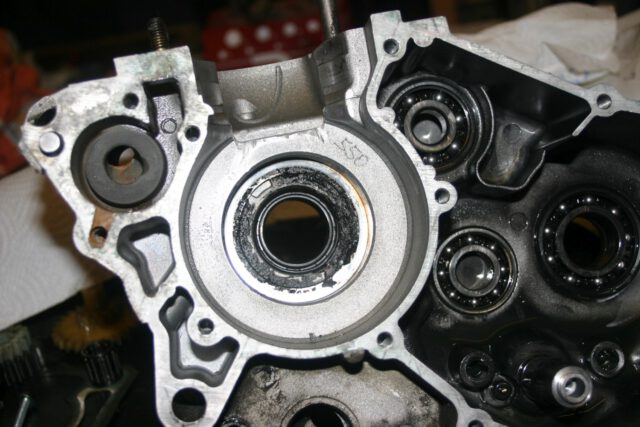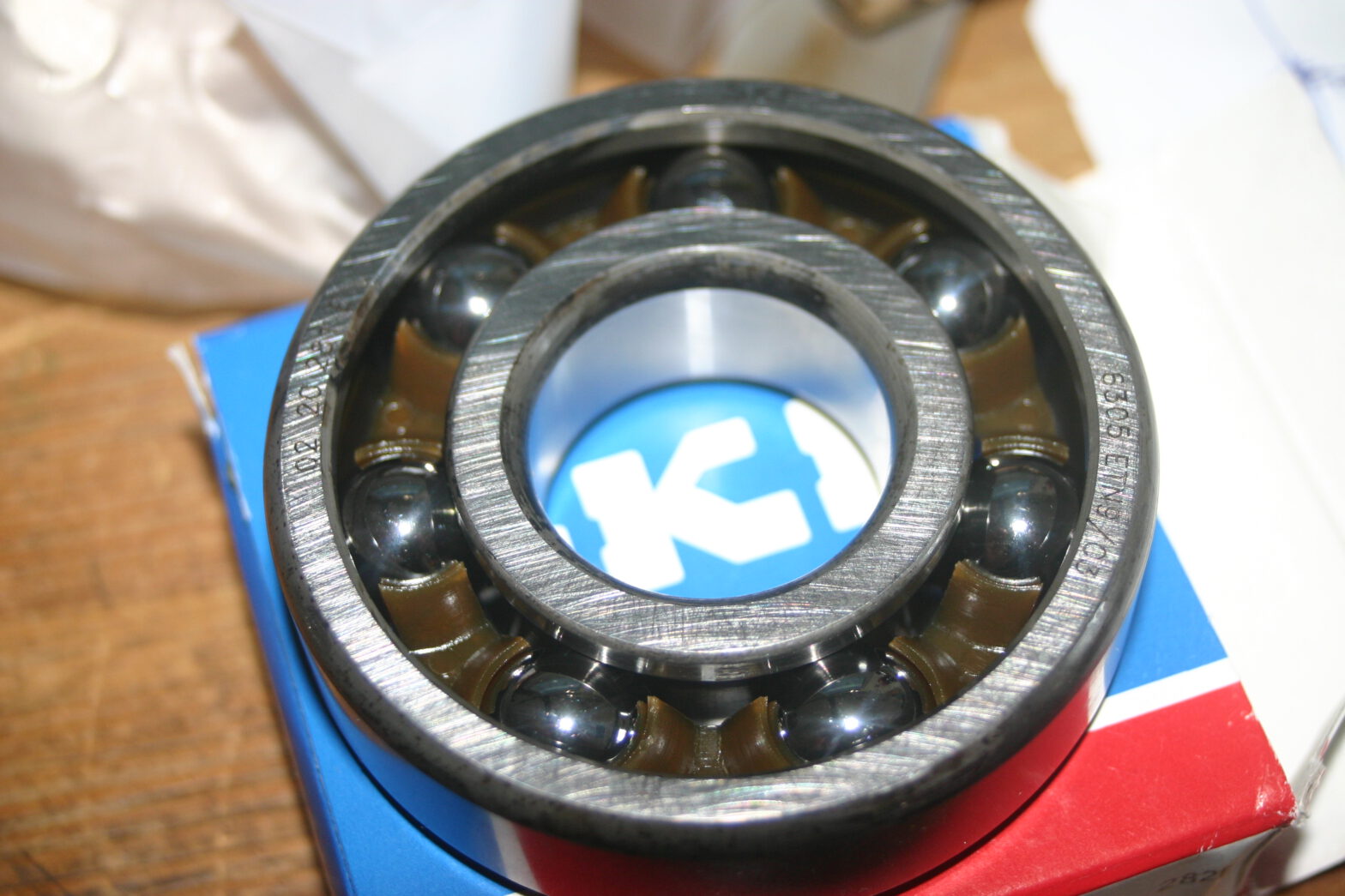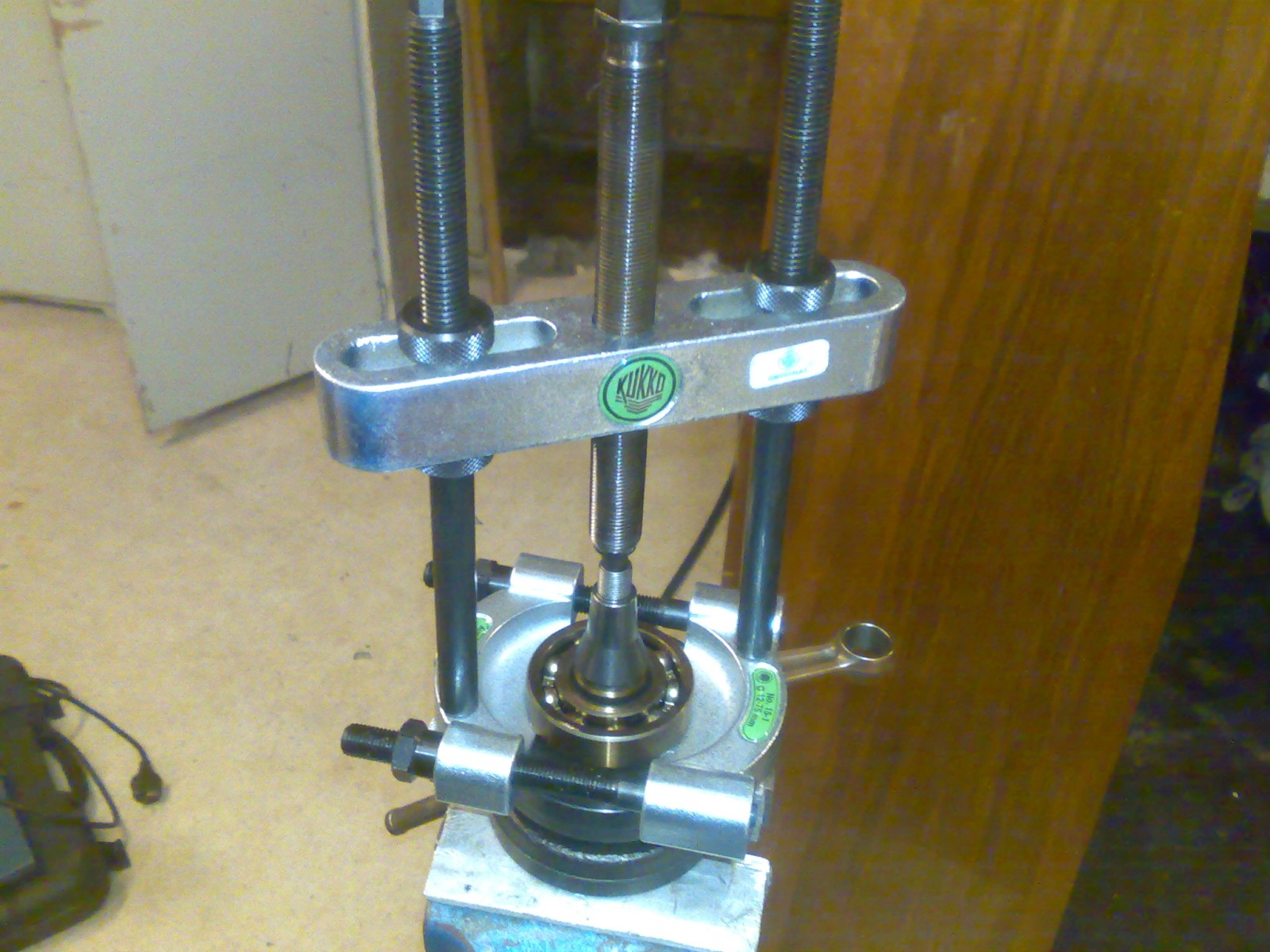The following bearings are installed in the engine of the RS 125, both Rotax 123 and Rotax 122.
All bearings must be installed without sealing washers.
Crankshaft:
- 6206 ETN9 C4 on both sides
Balance Shaft:
- 6302 TN9 on ignition side
- 6005 TN9 C3 on clutch side
For the following gearbox bearings, a normal bearing with steel cage can also be used to save costs instead of polyamide cages. When ordering, simply order without the suffix TN9.
Input shaft / primary shaft:
- Ignition side: 6203 TN9 C3 (e.g. SKF 6205 ETN9/C3)
- Clutch side: 6205 TN9 (e.g. SKF 6205 ETN9)
Output shaft / secondary shaft:
- Ignition side: 6205 TN9 (e.g. SKF 6205 ETN9)
- Clutch side: 6203 TN9 C3
The shaft seals on the crankshaft are on both sides: 28 x 38 x 7 WAS, which are installed so that the dust protection lip faces away from the crankshaft: The dust cover lip is on the outside of the alternator or towards the clutch. It is possible to use a shaft seal without a protection lip towars the clutch to reduce friction, as both sides are lubricated and should not be containing any dust or dirt.
Transmission output shaft: 25 x 38 x 7 WAS
Water pump: 10 x 26 x 7 (2 pieces)
Gear switch shaft: 12 x 22 x 7 WAS (Rotax 122) or 12 x 28 x 7 WAS (Rotax 123)
Bearing suffix: clearance and cage
The suffix TN9 stands for bearing cages made from polyamide 66, which are quieter, have higher load ratings and are also fitted ex works than the standard design with steel cages. More cheap bearings with steel cages can also be fitted to the gear shafts (but are not recommended for the crankshaft and balancer shaft), although sealing washers must be removed to enable lubrication.
The bearing clearance, for example C4 for the crankshaft bearings, results from the fit used in the design of the engine and the operating temperature. The bearings have more clearance in the dismounted condition, as soon as they are mounted, the rings are compressed accordingly by the fits on the bore and shaft. The crankshaft bearings are also designed in an X-arrangement and the bearings are preloaded accordingly (hence the shim rings, which are also described in the workshop manual). A reduction in the bearing clearance (C3 instead of C4) results in the bearing being subjected to too high a load and thus wears out relatively quickly. Under no circumstances may the specified bearing clearance be deviated from.
Removal of crankshaft bearings
After removing the crankshaft, the crankshaft bearings are still stuck on the crankshaft.
There is only one valid tool to remove the bearings, called a bearing separator:
Screwdrivers and other attempts at leveraging lead to nothing, this is dangerous bungle and should be called so. Do not even try it. You just slip and ram the screwdriver into your hand. Even claw pullers unfortunately do not fit. If you don’t have the tools, you only have three options: Take the whole shaft to the nearest workshop (probably this doesn’t even cost anything), borrow the tool (difficult) or just buy the tool.
Remove sealing discs
All sealing washers or shields must be removed before installation. In the gearbox, the bearings are submerged and surrounded by the gearbox oil, the bearings of the main crankshaft are lubricated and cooled by the petrol/air mixture.
Sealing washers or cover plates can be levered out of the bearing with a screwdriver.
If you nevertheless install sealing washers on the crankshaft, it can happen that they decompose or melt, as the following picture shows impressively. The sealing material is normally not suitable for the conditions at the crankshaft, which can lead to engine damage.





Hey man. I don’t know about that seal orientation on the crankshaft. I’ve seen people have leaks on the clutch side seals because “the correct way” is to install that seal with the dust lip facing the clutch. Dunno if this is true but I guess I will find out when I put mine beach together.
Cheers!
I have a very important question. The manual states that the orientation of the crankahaft bearings is important but the desceiption is not clear whether the open side of the cage should face the crankshaft or the other side
Greetings!
Great info. I do have a question.
Original crankshaft (Big End) bearings have a 2.5mm hole drilled into the outer race, at approx. 2.5 mm from the edge (outer side away from the crankshaft), which are supposed to line up with Oil Transfer Passages within both L/H and R/H case halves.
None of the aftermarket replacement bearings come with such drilled holes.
What are your thoughts on the level of lubrication provided to aftermarket bearings without utilising Oil Transfer Passage design and their longevity?
Cheers, Paul
Hi paul, I have to be honest, I don’t know about this.
I don’t remember exactly how the bearings of the first engine I repaired looked like, but the second one I fixed already had the bearings replaced with the wrong bearings (they were worn out because of the wrong gearing play). Both engines I was working on had no issues with the bearings, one was my own engine which I sold after it had about additional 10k km the other engine with the wrong bearings was from a friends RS, never received any complaint.
There is also no such alignment of holes described in the engine repair manuals I have, neither for the 122 or the 123.
The RS 250 actually has such holes and the bearings are getting aligned by pins which are pressed into holes in the outer bearing ring. But on the 123 or 122 engines I never noticed this or read about it in the official manuals. As I understood, the lubrication is just lead to the bearing balls through the passage from the top around the corner of the outer ring or spacer.
As far as I can tell, 6206 ETN9 C4 work fine without any issues.
My current RS is from 1997 and the engine was never touched, I will definitely try to see if there are such holes and how they are aligned when having to overhaul the engine.
Thanks for your comment and regards, Viktor
Bonjour Viktor et la communauté,
Je m’appelle FRED et je réside en France. Je restaure mon Aprilia 125rs de 1997 à rotax 123 (5000kms).
J’ai trouvé près de chez moi une entreprise qui vend des roulements (pas de marque). Pour la petite somme de 40€, j’ai eu :
MOTEUR :
6206 zz C3 (x2)
6205 rs C3 (x2)
6203 2rs C3 (x2)
6005 rs C3 + Z C3
(il me manque le 6302)
ROUE :
6004 2rs C3 (x2)
6204 2rs C3 (x2)
Ma question concerne surtout ceux du moteur, car il sont tous étanches (plastique ou acier). Il m’ont dit que je pouvais enlever les protections ???
Est qu’ils sont compatibles, ou je me suis fais avoir ??
Merci à tous. Cordialement FRED
Bonjour Fred,
des roulements à billes avec un jeu “C4” doivent être installés sur le vilebrequin. Les roulements dont le jeu est trop faible (C3) s’usent rapidement.
Il est courant que les roulements soient vendus avec des protections métalliques ou des rondelles d’étanchéité que vous pouvez simplement retirer à l’aide d’un tournevis. Les roulements à billes seront toujours adaptés. Ceux-ci sont probablement mieux en stock.
Toutes nos salutations et bonne chance !
Bonjour Viktor, encore merci de votre retour..
Donc je commande juste ceux du villequin (6206 TN9 C4)??
Le reste devrait correspondre ??
Merci.. Et bon week-end de pâques. Cordialement FRED
PS (Avez-vous reçu le mail ou je faisais des éloges de votre site… je vous fais plein de pub vers mes collègues français)